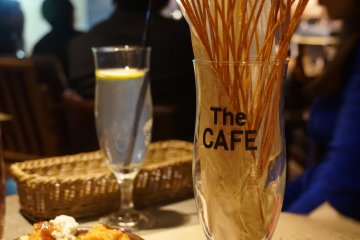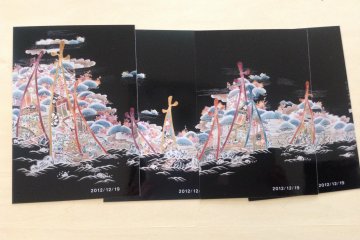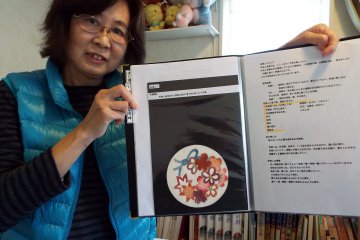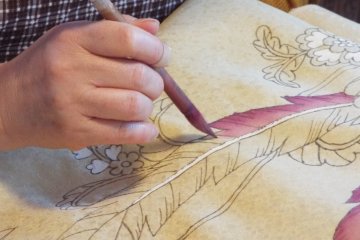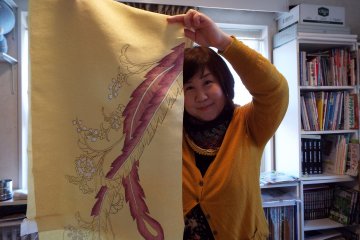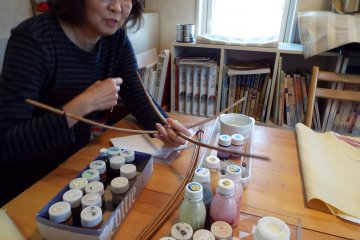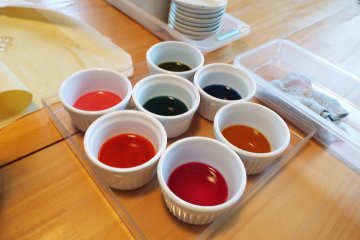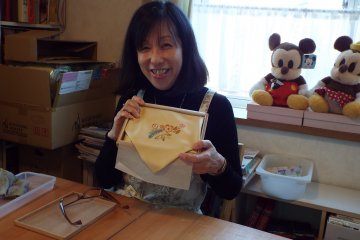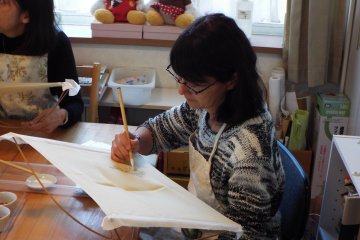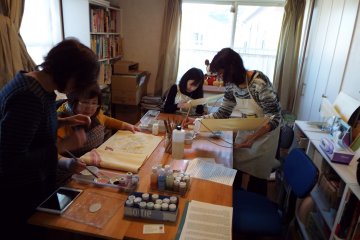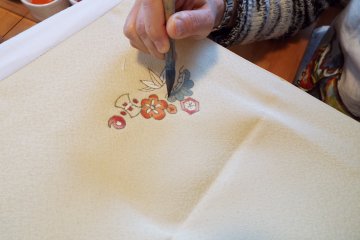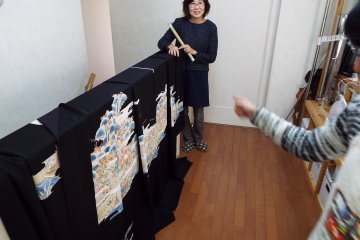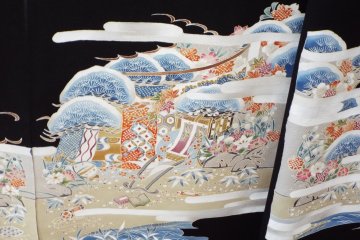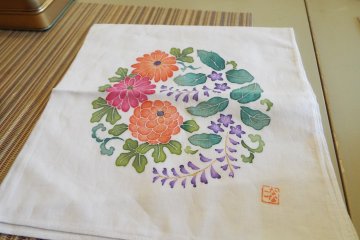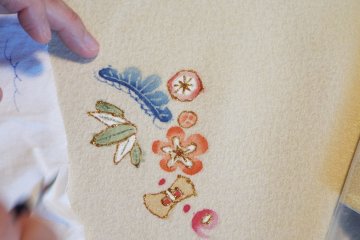Miwa recently met her Jr. high school friends at a reunion and discovered one lady was a seasoned artist who taught classes on how to dye cloth for kimonos. So she enrolled in the next class. I decided to attend so I could see first hand how this intricate process works.
After about fifteen minutes of watching a master giving instructions I was mesmerized with how it all comes together.
Our instructor Nanako Yakura has over twenty-five years experience in design, dying and finishing the final kimono. She makes one per year and sells them at almost one-third the rate of the professional stores.
There are two types of silk fabrics from which kimonos are made. One is colored first and then weaved. The other is called Yuzen where the kimono is first hand drawn and then dyed. Yuzen Dyeing was invented around 1700 during the Edo period.
Yakura-san’s specialty is designing and making Yuzen kimonos.
There are many types of Yuzen, Tomesode high end formal wear is made specifically for (TPO) Time, Place, & Occasion.
- Kuro-Tomesode (Black) used for formal ceremonies such as marriage. Married ladies wear these to the ceremony of relatives.
- Iro-Tomesode ia a single color other than black with the pattern below the waist. Also worn by married ladies to a relative’s wedding.
- Houmonngi, with the pattern all over the garment, is semi-formal for visiting by married /unmarried women and would be used for attending wedding ceremonies of friends.
- Furisodie is formal wear for single ladies when coming of age, at weddings, and other formal ceremonies.
- Tsukesage is casual wear and the patterns have to be connected to each other on the front of the kimono only.
We began with two other students who were at advanced levels and worked on different projects. They were also Miwa’s former classmates. (Classes are limited to three people) We started with a piece of cloth that was designed by Yakura-san. It had a floral outline using dyed glue, which later on in the process will disappear.
This cloth called Fuksua is used as a gift included with money. The brushes are made of various animal hairs. Yakura-san prefers the hair of the raccoon and the weasel.
White dye is created from baked seashells made into powder and mixed with paste. White and Red signify cherry blossoms, and the big pedal is happiness. Flowers titled “Bouquet” are for young ladies to celebrate happiness.
All designs have meanings and the designer catches the recipient’s desires and then designs for that purpose.
Yakura-san likes to paint with bright colors that are gorgeous. (White, orange, red, yellow, green, purple, blue, indigo) She said painting with bright colors reflects happiness. She strives to make all patterns that when the wearer raises her arms the design becomes one and when it is hung up it becomes a decoration.
She draws a picture, makes the design cloth with rice cake powder for glue, and then hand draws both inside and outside the cloth.
After dying she places the cloth into steamers with a towel and newspapers for 40 minutes (the paper attracts the glue) to insert the dye into the cloth. After steaming, the cloth is placed in lukewarm water to wash away the glue. Finally, it is rolled in a towel and ironed dry.
To add gold into the design she uses gold glue placed into a tube and slowly squeezes an outline onto the cloth.
A professional shop will sell a kimono for 1 million yen or more and hand painted for 2 million yen and up. When she explained to me how long it takes to hand make one kimono I immediately realized why they are so expensive. For Yakura-san the design alone may take 3 months, 2 weeks to put the outline on cloth, one week for outline paste to dry, an additional 2-3 months to correctly apply the dye, and one day to wash, take off glue and make any corrections.
Yakura-san makes Kimono for the Tohoku region for those who lost a loved one and their kimono during the 2011 earthquake disaster. The design is a dance with fan, a feather of the mythological Phoenix to make a bridge to heaven and the relative. Her goal is to bring happiness to the family in heaven. Yakura-san is vey involved with volunteer groups that donate to ladies in need
She showed us a beautiful black kimono (kuro-Tomesode) she is making for her son’s future wedding. The intricate design and colors were so subtle that you would never guess this was made from a dyeing process.
There is even more to this such as adding a family crest, which is hand painted in the size of a postage stamp using Indian ink.
I even tried applying dye onto the cloth Miwa was working on. It takes a steady hand and focused eye to not make a mistake. When we finished Yakura-san carefully packaged our cloth for us to display at our home.
Yakura-san said, “Yuzen is my mission and I want to be a point on the long line of Yuzen history.”
She currently is not accepting any new students, but you can e-mail her as to when an opening may become available or check the web for other classes offered throughout the country. Also feel free to email her e-mail for pricing, availability, and directions to the school (nanakoykr@aol.com ).
The art of kimono dyeing is another great learning experience that you could add to your trip to Japan.






